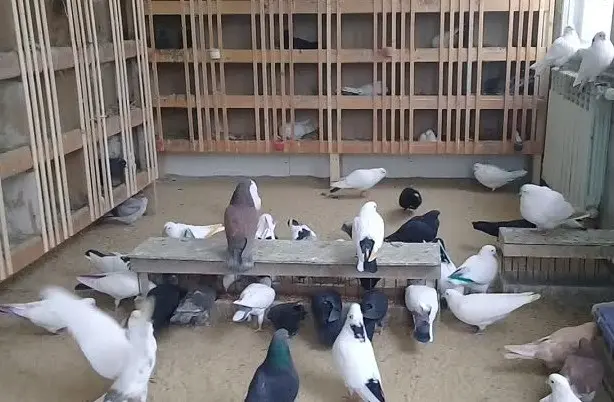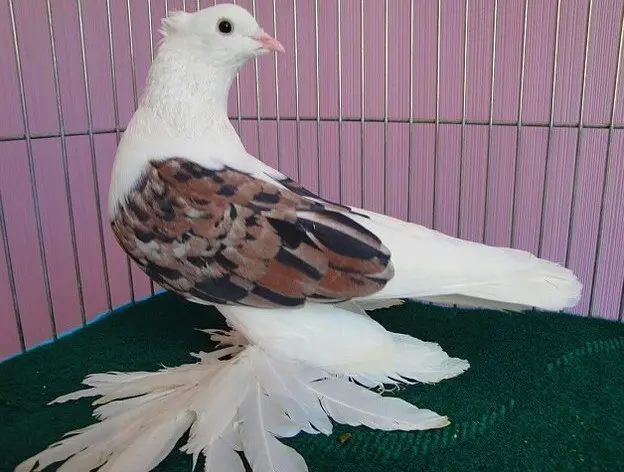Contents
Iranian pigeons are a domestic pigeon breed from Iran. Her homeland is three large cities of the country: Tehran, Qom and Kashan. Iranians have been raising pigeons since time immemorial for endurance and flight beauty competitions. In Europe, the Iranian pigeon is known as the Persian highland pigeon.
History of Iranian war pigeons
The ancestors of the first Iranian large fighting pigeons lived in Persia, on the territory of which modern Iran is located. They began to breed them several thousand years BC. e. Wealthy people and rulers of the country were engaged in pigeon breeding.
Pigeon sport – competition for endurance and the quality of the flight of pigeons originated in the city of Kashan, and then spread throughout the world. In ancient times, competitions were held in the spring, and the number of participants was small (up to 10 birds). Nowadays, hundreds of pigeons take part in demonstration performances. For judges, not only the flight is important, but also the appearance of the participants.
Pigeon breeding is an ancient tradition of the Iranians, which is still alive today. Dovecotes can be found throughout the country, some of which resemble small palaces. The droppings of hundreds of pigeons are used by people to fertilize the marginal Iranian lands. The occupation of breeding these birds is considered sacred, they are kept not only in the countryside, but also in cities. In any region of the country, you can find specialized stores for the trade in Iranian fighting pigeons of local selection. The owners of these institutions, called Saleh, are wealthy and respected people.
A distinctive feature of pigeon breeding in Iran is that there is no generally accepted standard for fighting pigeons. They are not put on display for experts to assess the exterior, only the endurance and beauty of the flight of birds matter. Selection is carried out only in this direction. Unlike Iranian pigeon breeders, fanciers improve the breed in several directions at once – they improve the appearance and flight qualities.

Appearance
The fighting pigeons of the Iranians are characterized as proud, strong, harmoniously built birds. At the exhibition, great attention is paid to the color, size and shape of the body, the flight of pigeons is evaluated, and the ability to return to their place.
The body length of the Iranians is measured from the beak to the tip of the tail, it must be at least 34 cm and up to 36 cm. If a forelock grows on an elongated head, the variety is called “bearded”. For forelock Iranian pigeons, a pure white color with a trimmed beard is desirable, the back of the forelock is white.
Birds can be with a smooth head, this variety is also called “headed”. The color or pattern for the chubby is pure white, with a bleed-off head. The characteristic color of the head is red, black, yellow and various intermediate options.
Other important characteristics of Iranian high-flying aircraft:
- black or dark brown eyes;
- thin beak 2,4 to 2,6 cm long;
- the chest is slightly convex;
- slightly elongated curved neck;
- long wings converge at the tail;
- the plumage is bell-shaped on the legs, up to 3 cm long, the fingers are bare;
- medium length legs.
Hamadan fighting pigeons of Iran are distinguished by long plumage on their paws. It prevents birds from moving quickly and freely on the ground, but in the sky they have no equal. The color of such pigeons is diverse – there are individuals with a colored tail, colored sides and one-color.
Flight
During the flight of Iranian war pigeons, the beauty of the performance is admired in the video. These birds are classified as flying breeds, they have their own style of “dancing” in the sky. For the characteristic clapping of wings in the air, pigeons are called fighting, they fly up, making somersaults through the tail. The strongest members of the pack try to stand out and fly as high as possible to show all their talents. The flight is distinguished by a slower wing beat than other breeds, the ability to hover in the air and perform somersaults.
Iranians have a strong, flexible skeleton. Powerful wings and a streamlined body make it possible to perform coups in the air. A special respiratory system allows you to get more oxygen, and makes the birds incredibly hardy. Pigeon breeders claim that Iranian combatants can spend up to 12 hours a day in the air. They fly very high, sometimes out of sight.
Iranian pigeons catch air currents, can soar and tumble for hours at a height. They are resistant against the wind, and perfectly cope with turbulent flows. Birds have excellent visual memory, which helps them remember landscape and landmarks. Thanks to ultraviolet vision, birds can see the earth through clouds.
Varieties of Iranian pigeons
In Iran, there are a large number of fighting Iranian pigeons, in addition to the heady and tickled varieties. Any city can boast of its unique view. But they all have similar features that are characteristic of the entire Persian region. Varieties of Iranian pigeons:
- Tehran high-flying most popular with pigeon breeders. They have a large wingspan, reaching 70 cm in some individuals. Among their Iranian counterparts, they stand out with a rounded head and a short, strong beak. The plumage can be of different colors – post der, post halder, dest pari.

- Hamadanskie komaschi belong to the most beautiful pigeon breeds. the plumage on the legs of these birds can reach 20 cm. This oldest Iranian variety of pigeons is represented by several breeding lines, among the representatives of which there are differences in the color of the plumage, the length of the beak, and decorations on the head. The advantages of the Hamadan cosmonauts include excellent flying qualities, they can spend up to 14 hours in the sky. In combat, they are significantly superior to bare-footed breeds.

- Tibriz pigeons or Iranian high-flying – a variety common in the western part of Iran. Birds are characterized by an elongated body and an oblong head. The appearance is similar to the Baku fighting pigeons, most likely, the breeds have common ancestors. Of great importance for this variety is the purity of the color, it should be perfectly even without blots.

Combat characteristics
When taking off into the sky, the bird beats its wings in the air, the nature of such a battle is different. It should be well audible to people standing on the ground, this is the value of the breed. Combat types:
- corkscrew – circling in a spiral while playing wings, to improve the flight, training is required at least 2 times a week;
- pillar – taking off from the ground in a strictly vertical direction with small circles, during the flight the bird makes characteristic sounds, and after climbing it somersaults over its head;
- butterfly game – characterized by frequent flapping of wings, the desire for single flights.
It is a great pleasure to contemplate the flight of Iranian white war pigeons in the sky. You can witness this spectacle at an exhibition and competition or when visiting pigeon farms. During the competition, the judges evaluate the strong and high-altitude fight, the duration of the flight in different styles.
Recommendations on the content
The dovecote is protected from drafts and dampness. Birds are not afraid of frosts, so there is no need for individual heating – healthy individuals tolerate a decrease in air temperature to -40 ° C. The pigeon house is spacious, protected from the entry of cats and rats. To save time on cleaning, the floors are made slatted. Perches and nesting compartments are built in each dovecote, feeders and drinkers are placed on the floor.
Pigeons should always have clean water and food. They use special feeders and drinkers with canopies on top that prevent contamination of the contents. Flight breeds during the rut should not be fed with heavy food. Healthy birds should be half-starved.
Pigeons are fed different grains:
- lentils or peas (source of proteins);
- wheat and millet (carbohydrates for energy);
- flax seeds (contain fats);
- anise seeds (delicacy).
The following cereals may also be included in the grain mixture:
- oats;
- barley;
- corn;
- rice;
- sunflower seeds.
Pigeons are given food 2 times a day strictly according to the schedule, at 6.00 or 9.00 and 17.00. In addition to grain, mineral supplements are needed – shell rock, purified sand and liquid or tablet vitamins. While the chicks are being fed, food is given 3 times a day – in the morning, afternoon and evening, at the same time. In winter, birds also need three meals a day.

The amount of feed per day is calculated based on the number of livestock and the period of life of birds:
- one young bird per day requires about 40 g of grain mixture;
- during molting give 50 g of grain for each individual;
- during the period of laying eggs and breeding, each pigeon is allocated 60 g of cereal crops.
In Iran, preparations for flying competitions begin 50 days before the due date. During this time, the birds molt and gain the necessary shape. Pigeons are not chased during molting, they are given a varied, high-quality food with a high protein content. Active training starts a week before the competition.
If the birds are given good care – high-quality food, clean water, they will live a long time. Vaccinations are also needed, keeping dovecotes clean, and preventing common bird diseases. The average life expectancy of a healthy pigeon is 10 years, some live up to 15.
Conclusion
Iranian pigeons are incredibly hardy and quick-witted. The best representatives of the species are not inferior in intelligence to a 3-year-old child. The beauty of the flight of fighting pigeons is striking. Birds are bred in Our Country not only for the sake of flying qualities, they monitor the exterior. There is a strict standard for Iranian high-flyers with descriptions of color, proportions and body size. In content, Iranian pigeons are unpretentious; before competitions and exhibitions, they need many hours of training. For the health of pigeons, it is important to observe the regularity of feeding, maintain cleanliness in the dovecote and prevent bird diseases.












